Find a particular solution satisfying the given condition for differential equations dy/dx y tan x = 2x x^2 tan x, given that y = 1 when x = 0 asked Aug 11 in Differential Equations by Ghanshyam01 ( 72k points)Verify that x^2 cy^2 = 1 is an implicit solution to \frac {dy} {dx} = \frac {xy} {x^2 1} If you're assuming the solution is defined and differentiable for x=0, then one necessarily has y (0)=0 In this case, one can easily identify two trivial solutions, y=x and y=x If you're assuming the solution is defined andDy dx = x2 y = x2 {z} g(x) 1 y {z} f(y) 2 Separate the variables y dy = x2 dx 3 Integrate both sides Z y dy = Z x2 dx y2 2 = x3 3 C 0 4 Solve for y y2 2 = x3 3 C 0 y2 = 2x3 3 C y = r 2x3 3 C Note that we get two possible solutions from the If we didn't have an initial condition, then we would leave the 2in the nal answer, or
If X 2 Y 2 2 Xy Find Dy Dx Sarthaks Econnect Largest Online Education Community
Find (dy)/(dx) f-1.2quad (x+y)^(2)=4
Find (dy)/(dx) f-1.2quad (x+y)^(2)=4-Let's look more closely at how d dx (y 2) becomes 2y dy dx The Chain Rule says du dx = du dy dy dx Substitute in u = y 2 d dx (y 2) = d dy (y 2) dy dx And then d dx (y 2) = 2y dy dx Basically, all we did was differentiate with respect to y and multiply by dy dx If x = a sec3 θ, y = a tan3 θ, find dy/dx at θ = pi/4 Welcome to Sarthaks eConnect A unique platform where students can interact with teachers/experts/students to get
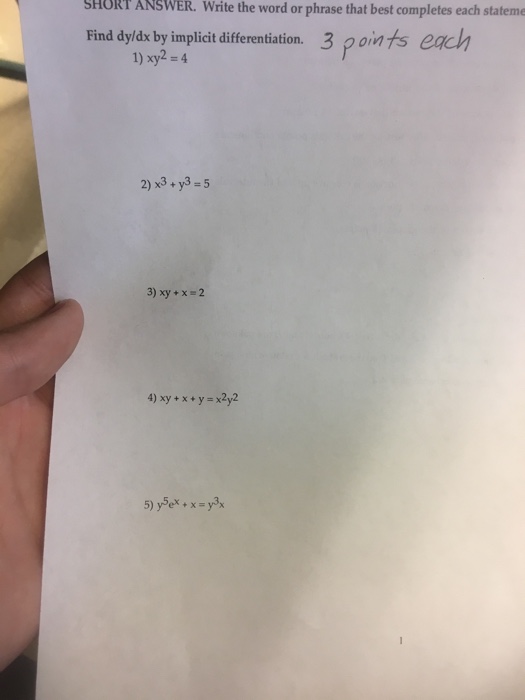



Find Dy Dx By Implicit Differentiation Xy 2 4 X 3 Chegg Com
Therefore, we have obtained the following linear equation with respect to the derivative $$$ 3 x^{2} 3 y^{2} \frac{dy}{dx} = 2 x \frac{dy}{dx} 2 y $$$ Solving it, we obtain that $$$ \frac{dy}{dx} = \frac{3 x^{2} 2 y}{2 x 3 y^{2}} $$$Find dy/dx given x^3 3 x^2 y 2 x y^2 = 12 Natural Language;Find `(dy)/(dx)` when br `y= (x^(3)* sqrt(x^(2)12))/( 3 sqrt(3x))" when " x=4` Welcome to Doubtnut Doubtnut is World's Biggest Platform for Video Solu
Solve the differential equation dy/dx = y/x Solve the differential equation dy/dx = y/xLet f(x) = 3x^4 2x^2 10 f(xh) = 3(x^4 4x^3 h 6x^2 h^2 4xh^3 h^4) 2(x^2 2xh h^2) 10 f(xh) f(x) = 12x^3 h 18x^2 h^2 12xh^3 3h^4) 4xh 2h^2 (f(xh)f(x))/h = 12x^3 18x^2 h 12xh^2 3h^3 4x 2h Take the limit of thisMath Input NEW Use textbook math notation to enter your math Try it
Share It On Facebook Twitter Email 1 Answer 1 vote answered by Prerna01 (521k points) selected by RahulYadav Best answer Given (x y) 2 = 2axy Differentiating the equation on both sides with respect to x, ← PrevTranscribed image text dx 5 If y=x2 4x and x = 122 1 ; This is a first order separable differential equation dy dx = y2 −4 dy y2 −4 = dx ∫ dy y2 − 4 = ∫dx Perform partial fraction 1 y2 −4 = A y 2 B y − 2 = A(y − 2) B(y 2) (y2 − 4) Compare the numerators 1 = A(y −2) B(y 2)




5 A 3 Points If X 3 Y 3 Xy 2 5 Find Dy Dx Solution Differentiating Both Sides Course Hero




Find Dy Dx Y X 2 1 3 2x 1 Sqrt X 3 4x 1
Transcript Ex 96, 3 For each of the differential equation given in Exercises 1 to 12, find the general solution = 2 = 2 Differential equation is of the form = where P = 1 and Q = x2 Finding integrating factor, IF = e IF = e 1 IF = e log IF = x Solution is y (IF) = yx = 2 yx = 3 yx = 4 4 Click here 👆 to get an answer to your question ️ Find dy/dx 1 If y = x^4 1/x^2 x Find dy/dx Brainly User Brainly User Chinese Secondary School answered Find dy/dx 1 If y = x^4 1/x^2 x Find dy/dx 1 See answer UserD/dx x^2 y^4, d/dy x^2 y^4 Natural Language;
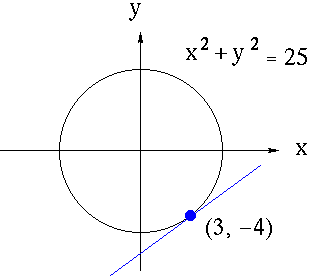



Implicit Differentiation
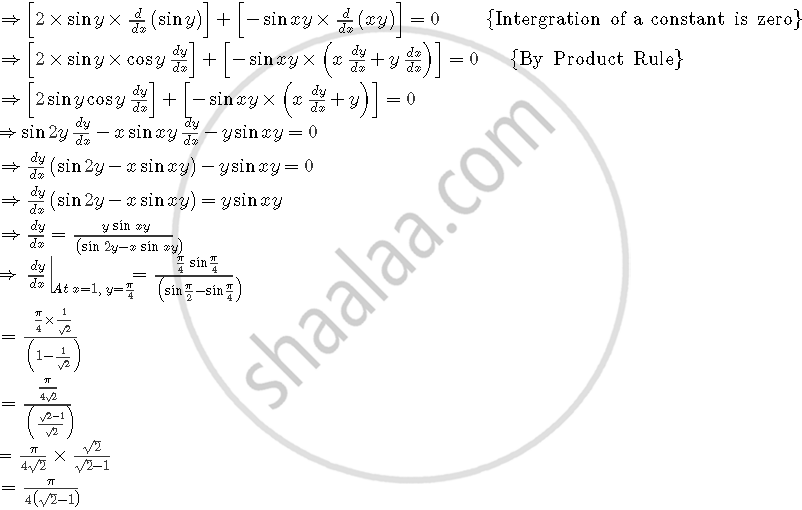



Find Dy By Dx At X 1 Y Piby4 If Sin 2 Y Cos Xy K Mathematics Shaalaa Com
How do you find #dy/dx# by implicit differentiation of #xy=4# and evaluate at point (4,1)? Example 4 Important Example 5 Example 6 Example 7 Example 8 Example 9 Example 10 Example 11 Important Example 12 Example 13 Important Example 14 Example 15 ImportantOnce again I have some crazy relationship between x and y and just to get a sense of what this might look like if you plot all the X's and Y's that satisfy this relationship you get this nice little clover pattern and I plotted this off of Wolfram Alpha but what I'm curious about in this video is you might imagine from the title is to figure out the rate at which Y is changing with respect to



Www Lcps Org Cms Lib Va Centricity Domain 2 5 notes filled out Pdf
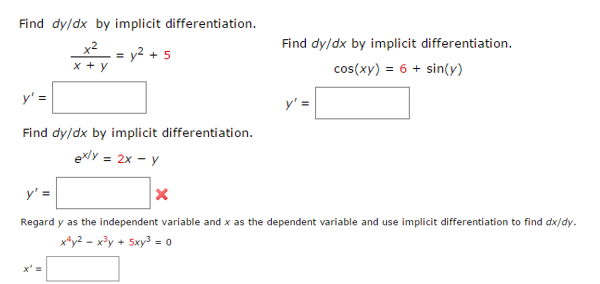



Find Dy Dx By Implicit Differentiation X 2 X Y Chegg Com
Find dy dt when t= t = √2 6 Find y'and y' for y =sin(x y) 7 Find y for sin x sin y =1 8 Find y' for x cos y =sin(x y) cosxcostIf y = 2^x, find dy/dx Q If y = 2^x, find dy/dx ANSWER 1) Take Logs of both sides of our equation y = 2^x So we get log (y)=log (2^x) 2) Apply relevant log rule to rhs Log rule log (a^b) = b log (a) nb the dot between b and log (a) represents x / multiply / times ) So we get log (y) = x log (2)1For each part, nd dy=dx (a) y= 3x3 2x2 p x Answer dy dx = 15 2 x3=2 3x1=2 (b) y= xe2x Answer dy dx = (2x 1)e2x (c) y= 1 2 sin( 2x) Answer dy dx = cos( 2x) (d) xy= x2 y2 Answer dy dx = 2x y x 2y (e) y= Z x 3 e t2 dt Answer dy dx = e x2 (f) y= ( 5x 2)4 Answer dy dx = 3( 5x 2) (g) y= R 2 x 3sin(t2)dt Answer 3sin(x2) (h) d dx



Find Dy Dx When X And Y Are Connected By The Relation X2 Y2 2 Xy Studyrankersonline




Engineering Mathematics Notes
2 dy/dx = y Select the second example from the dropdown menu, showing the differential equation dy/dx = y The initial solution is the x axis, but you can click/drag the magenta point to see other members of the solution family Transcribed image text Solve the initial value problem dy/dx = 2xy, y(0) = 4 A y = e^x^2 3 B y = e^x^z C y^2 = x^2 3 D y = 4e^x^2 E None Find the integrating factor to the first order linear equation, x dy/dx 3y = cosx A e^x^3 B ln x C x^3 D e^3x E Ex 56, 4 If x and y are connected parametrically by the equations without eliminating the parameter, Find 𝑑𝑦/𝑑𝑥, 𝑥 = 4𝑡, 𝑦 = 4/𝑡Here 𝑑𝑦/𝑑𝑥 = (𝑑𝑦/𝑑𝑡)/ (𝑑𝑥/𝑑𝑡) Calculating 𝒅𝒚/𝒅𝒕 𝑑𝑦/𝑑𝑡 " " = 𝑑/𝑑𝑡 (4/𝑡) 𝑑𝑦/𝑑𝑡 = 4 𝑑/𝑑𝑡 (1/𝑡




Find Dydx Where X 2 Y 2 3xy 1




Ex 5 6 1 Find Dy Dx X 2at2 Y At4 Class 12 Ex 5 6
This video screencast was created with Doceri on an iPad Doceri is free in the iTunes app store Learn more at http//wwwdocericomFind dy/dx y^2(y^24)=x^2(x^25) Differentiate both sides of the equation Differentiate the left side of the equation Tap for more steps Differentiate using the Product Rule which states that is where and By the Sum Rule, the derivative of with respect to isThe form of the equation shows that y ( x) is an even function So, we are looking for a solution on the form y ( x) = ∑ k = 0 n a k ( x 2) k O ( x 2 n 2) Note that the coefficient of x 10 is 0 helps in the solution Not sure how helpful this avenue is;




Solved Find Dy Dx By Implicit Differentiation Xy Sqrt X 2 Y 2
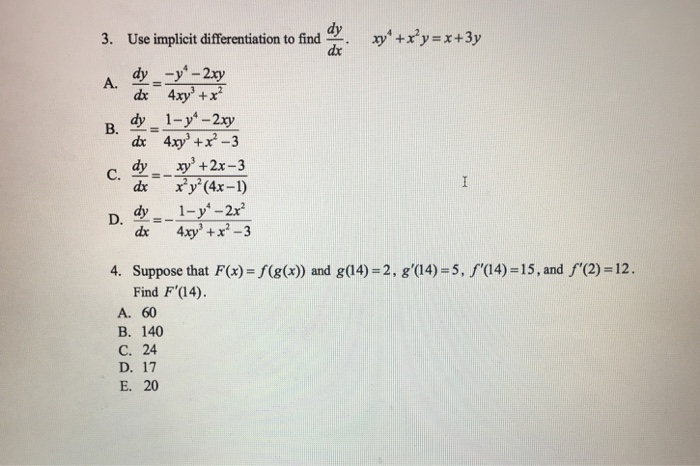



Use Implicit Differentiation To Find Dy Dx Xy 4 Chegg Com
Calculus Basic Differentiation Rules Implicit DifferentiationMath\begin{equation}\begin{split}(xy1)^2\dfrac{dy}{dx}=1\end{split}\end{equation}\tag*{}/math To solve this differential equation, the best trick Ex 56, 1 If x and y are connected parametrically by the equations without eliminating the parameter, Find 𝑑𝑦/𝑑𝑥, x = 2〖𝑎𝑡〗^2, y = 〖𝑎𝑡〗^4Here 𝑑𝑦/𝑑𝑥 = (𝑑𝑦/𝑑𝑡)/ (𝑑𝑥/𝑑𝑡) Calculating 𝒅𝒚/𝒅𝒕 𝑦 = 〖𝑎𝑡〗^4 𝑑𝑦/𝑑𝑡 " =" 〖4𝑎𝑡〗^ (4



If X Y Y X What Is Dy Dx Quora




Find Dy Dx By Implicit Differentiation Xy 2 4 X 3 Chegg Com
Answer to Find dy/dx using logarithmic differentiation y = ((2x^2 1)^4)/(sqrt(x 3)) By signing up, you'll get thousands of stepbystepSolve your math problems using our free math solver with stepbystep solutions Our math solver supports basic math, prealgebra, algebra, trigonometry, calculus and moreSo to calculate dx/dy, differentiate x with respect to y, or differentiate implicitly and then divide by dy Or if you've already calculated dy/d
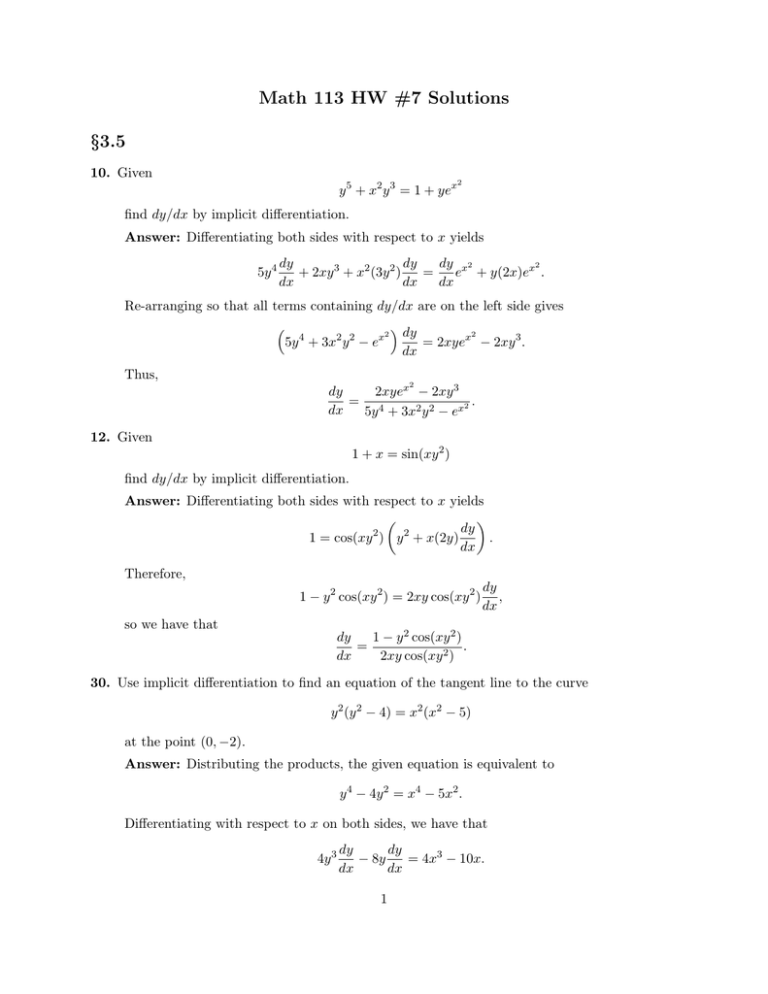



Math 113 Hw 7 Solutions 3 5




Answers To The Review Problems For The First Exam 251 05 10 In Spring 06
Find dy/dx y=4/x Differentiate both sides of the equation The derivative of with respect to is Differentiate the right side of the equation Tap for more steps Since is constant with respect to , the derivative of with respect to is Rewrite as Differentiate usingDy/dx means you differentiate y with respect to x, or differentiate implicitly and then divide by dx;Free implicit derivative calculator implicit differentiation solver stepbystep




Engineering Mathematics Notes



1
X^2 y^2 = 1, Find dy/dx by implicit differentiationFind dy/dx x^2xyy^2=4 Differentiate both sides of the equation Differentiate the left side of the equation Tap for more steps Differentiate Tap for more steps By the Sum Rule, the derivative of with respect to is Differentiate using the Power Rule which states that is whereSolution for Given equation is dy sin(x y) dx Q 34The graph of g consists of two straight lines and a semi circle Use it to evaluate each integr




How To Do Implicit Differentiation 7 Steps With Pictures
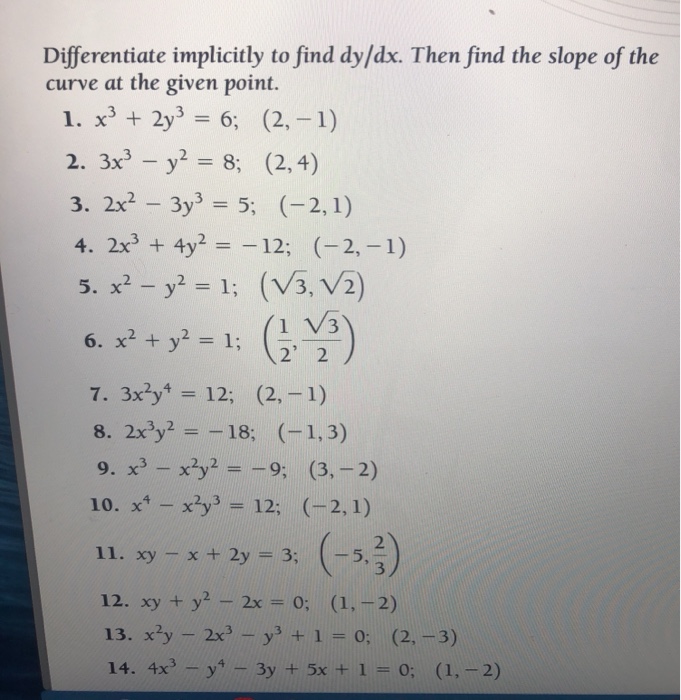



Differentiate Implicitly To Find Dy Dx Then Find The Chegg Com
Find dy/dx (x y) 2 = 2axy differentiation; Find the general solution of the differential equation dy/dx (secx)y = tanx, ( 0 ≤ x ≤ π/2) asked in Mathematics by Rubby01 ( 501k points) class12Extended Keyboard Examples Upload Random Compute answers using Wolfram's breakthrough technology & knowledgebase, relied on by millions of students & professionals For math, science, nutrition, history, geography, engineering, mathematics, linguistics, sports, finance




Implicit Differentiation Implicit Differentiation Is Used To Differentiate




Calculo 1 Given The Function Y 4 X 2 4 Arcsen X 2 Get Dy Dx Homeworklib
Now how did I know that, becuase `dy/dx` is 3x 2 2, y must be the integral of 3x 2 2 `dy/dx` differentiation and integration are opposite processes Ok, so I just integrate this and I get `x^3/3`, and there is 3 on the front, so the 3 cancels out so I just get x 3 2x KMaybe an analytic solution isn't easy to come by If x = a(cosθ logtanθ/2), y = asinθ , find dy/dx at θ = π/4 asked in Continuity and Differentiability by KumkumBharti ( 539k points) continuity



3 8 Implicit Differentiation Calculus Volume 1
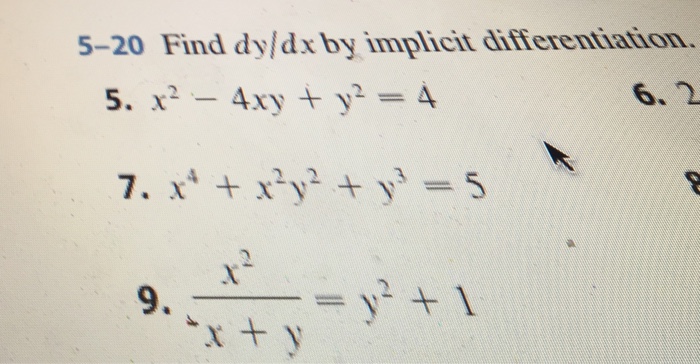



Find Dy Dx By Implicit Differentiation X 2 4xy Chegg Com
Find dy/dx xy=4 Differentiate both sides of the equation Differentiate the left side of the equation Tap for more steps Differentiate using the Product Rule which states that is where and Rewrite as Differentiate using the Power Rule which states that is where Multiply by Explanation differentiate implicitly with respect to x noting that d dx (y) = dy dx and d dx(y2) = 2y dy dx differentiate xy using the product rule 2xdy dx 2y 2ydy dx = 1 dy dx dy dx(2x 2y− 1) = 1 −2y dy dx = 1 −2y 2x 2y− 1 Answer linkTo ask Unlimited Maths doubts download Doubtnut from https//googl/9WZjCW Find `(dy)/(dx)` if `x^(2/3)y^(2/3)=a^(2/3)`




If Xy 4 Prove That X Dy Dx Y 2 3y Brainly In




Ap Calculus Consider Curve Given By Xy 2 X 3 Y 6 Find Dy Dx And Tangent Lines Youtube




Answered O Calculate 2 4 Y2 Dy Dx O Bartleby




Find Dy Dx When X 2 Y 2 4




Find Dy Dx Of Xy 3 Yx 3 X Mathematics Topperlearning Com D0amnv66




Solved Find Dy Dx By Implicit Differentiation Xy Sqrt X 2 Y 2



Find Dy Dx Of X 2 Y 2 2 4xy Sarthaks Econnect Largest Online Education Community




Find Dydx If X 2 Xy Y 2 100



Madasmaths Com Archive Maths Booklets Standard Topics Various Differentiation Ii Exam Questions Pdf




Find Dy Dx If X 2 Y 2 4xy
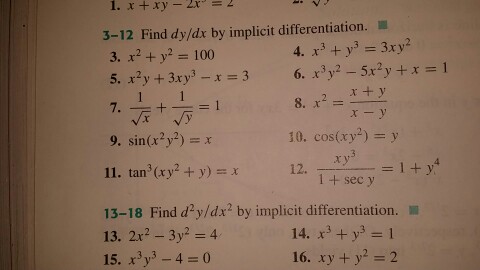



Find Dy Dx By Implicit Differentiation X 2 Y 2 Chegg Com




Q5 If X 2 Xy Y 2 100 Find Dy Dx Implicit Function If X2 Xy Y2 100 Find Dy Dx Youtube




How To Find D 2y Dx 2 Of X 2 Y 2 4 Youtube
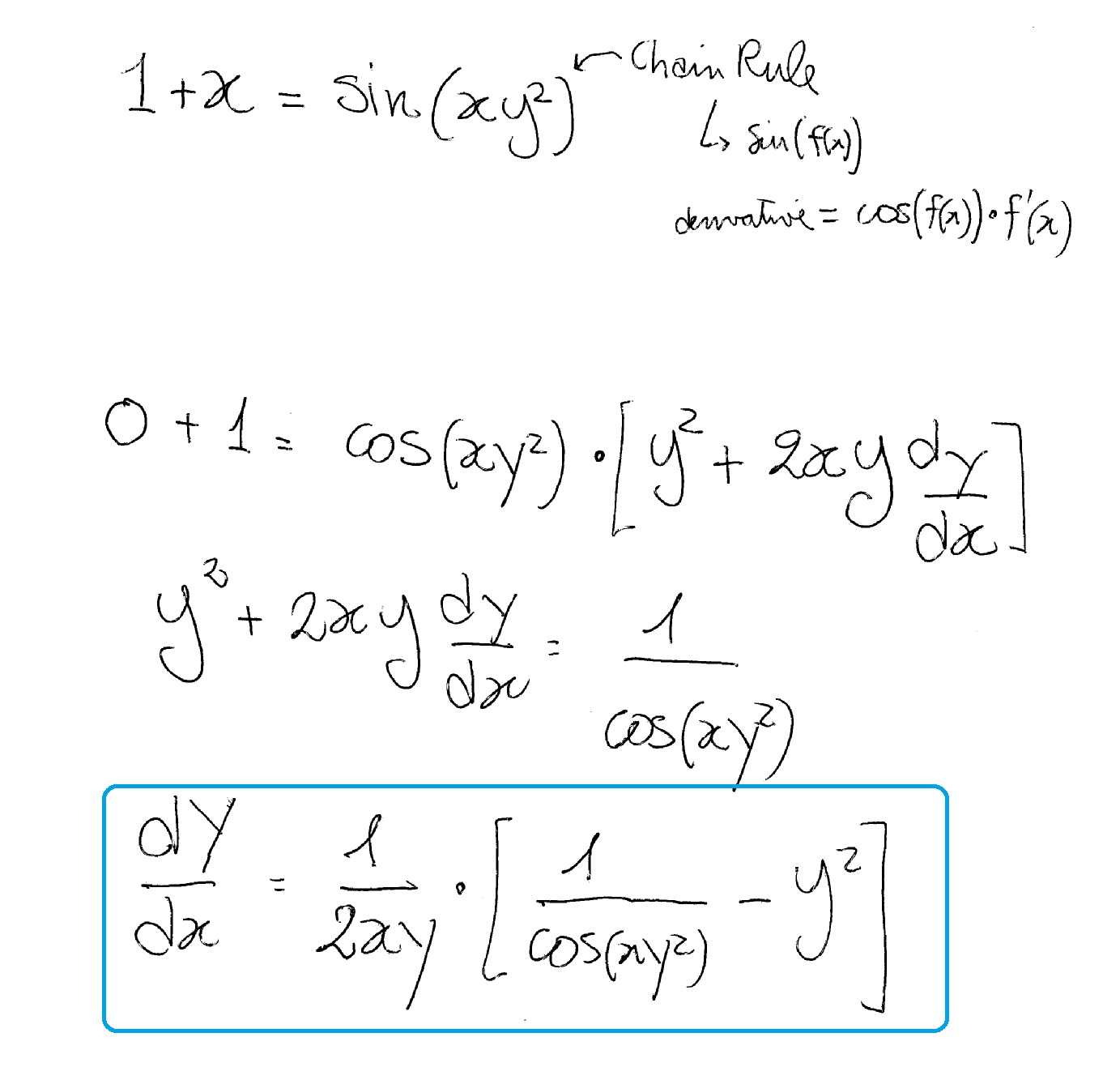



How Do You Differentiate 1 X Sin Xy 2 Socratic
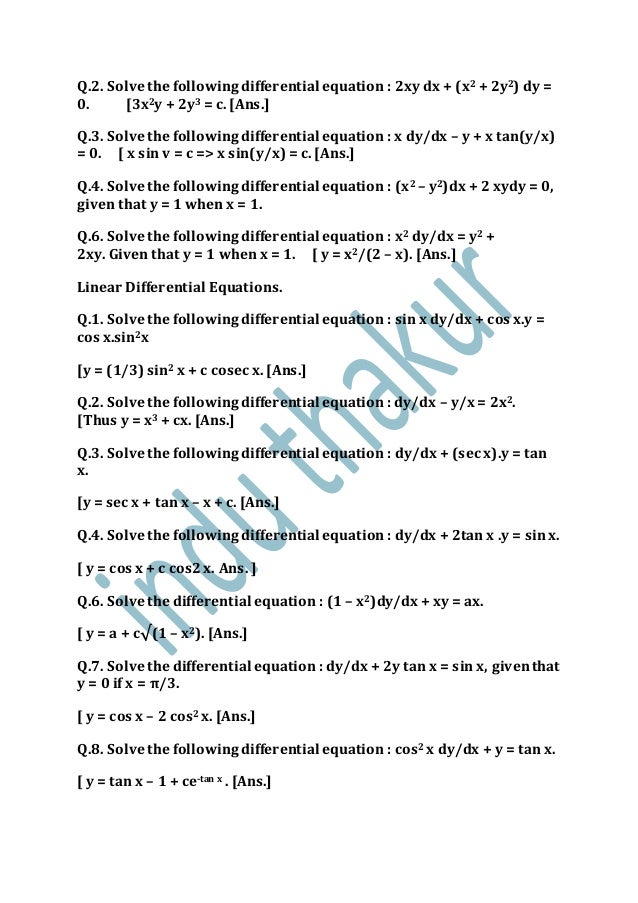



Practice Questions Calculus Xii




Worked Example Implicit Differentiation Video Khan Academy




Example 33 Find Dy Dx If Y X X Y X X A B Teachoo



4 2 Implicit Differentiation




Ex 9 4 16 For Xy Dy Dx X 2 Y 2 Find Solution




When X 2 Y 2 T 1 T And X 4 Y 4 T 2 1 T 2 Then How Do You Prove That Dy Dx 1 X 3y How Would You Solve This Quora




Find Dy Dx At X 1 Y Pi 4 If Sin 2 Y Cos Xy K




X 4 2x 2y 2 Y 4 Xy Find Dy Dx Brainly In



4 2 Implicit Differentiation



Www Wssd K12 Pa Us Downloads Calc mid Term review packet solutions Pdf




Ex 9 5 5 Show Homogeneous X2 Dy Dx X2 2y2 Xy Ex 9 5




Differentiation The Derivative And The Tangent Line Problem Ppt Download
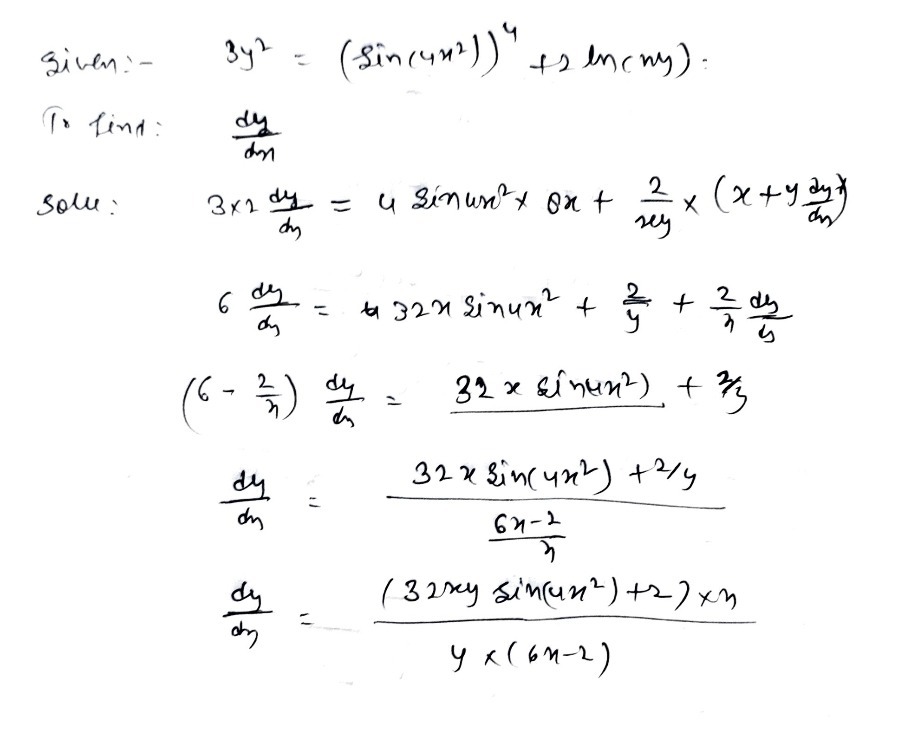



Ax 5 Find Dy Dx Ifsin 4x2 4 2ln Xy 3y3 Gauthmath




Section Implicitly Differentiate To Find Dy Dx Y 3 X 2 Ppt Download



3 8 Implicit Differentiation Calculus Volume 1



2 6 Webassign Answers




Solution Of X Y 2 Dy Dx A 2 A Being A Constant Is Youtube



How To Find Dy Dx Of The Function Y X 1 X 2 X 1 2 Quora




Find Dy Dx If Xy2 X2 4 Brainly In
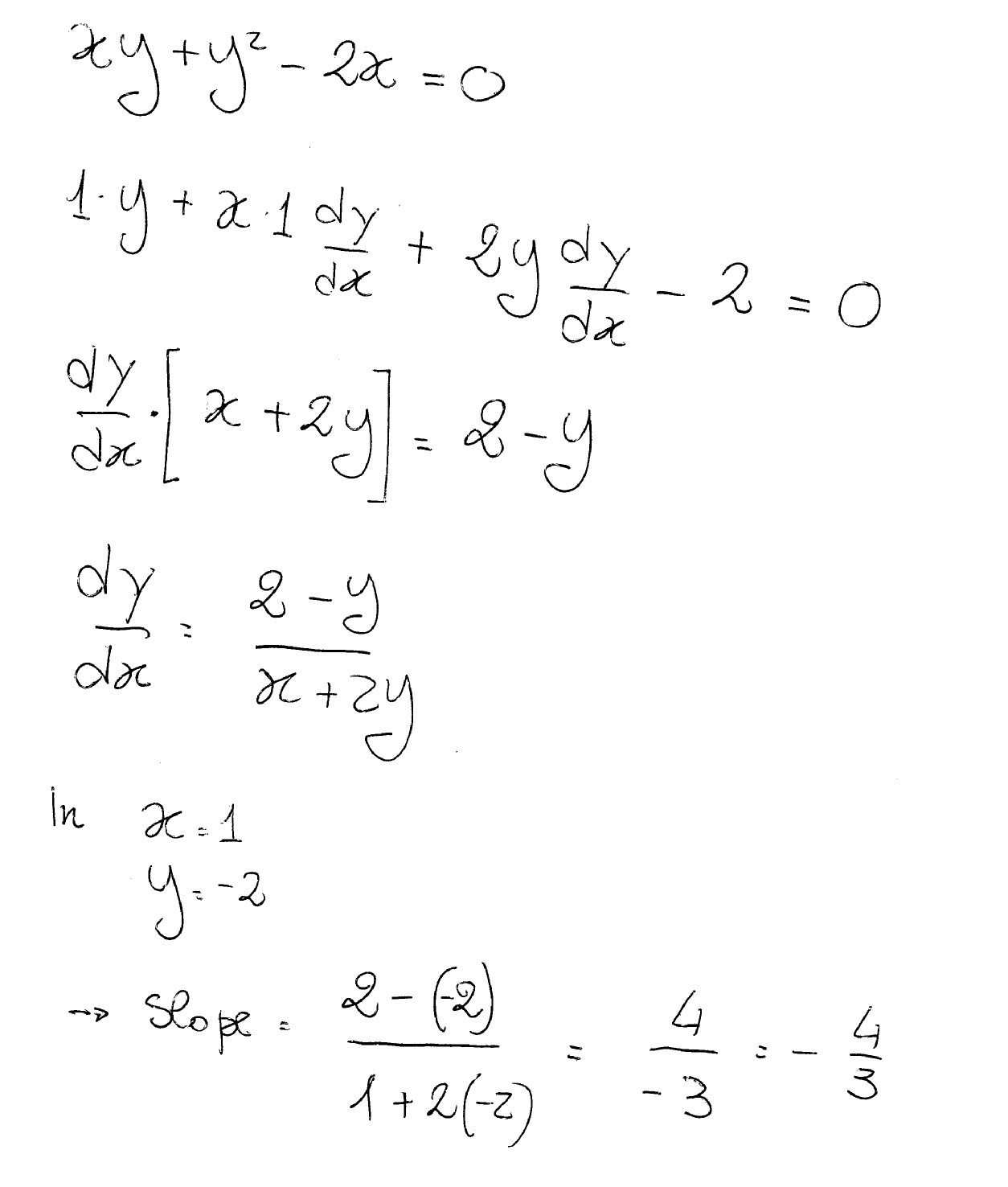



How Do You Differentiate Implicitly Xy Y 2x 0 To Find Dy Dx And Find The Slope Of The Curve At The Given Point 1 2 Socratic



Find Dy Dx By Implicit Differentiation Xey X Y Blog Lif Co Id



Www Lcps Org Cms Lib Va Centricity Domain 2 5 notes filled out Pdf




Find Dy Dx By Implicit Differentiation X 2 4xy Chegg Com




How To Do Implicit Differentiation 7 Steps With Pictures




Implicit Differentiation Advanced Example Video Khan Academy




If X2 Y2 2 Xy Find Dy Dx Mention Each And Every Step Mathematics Topperlearning Com Gwvwfskk



Secure Media Collegeboard Org Digitalservices Pdf Ap Ap16 Calculus Ab Q4 Pdf




Find Dy Dx Of X 2 Xy Y 2 100 By First Principle Of Derivatives Brainly In
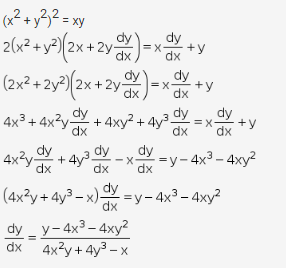



If X 2 Y 2 2 Xy Find Dy Dx Mention Each And Every Step Cbse Class 12 Learn Cbse Forum
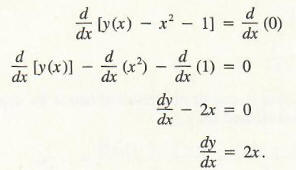



Find A Derivative With Step By Step Math Problem Solver




Rd Sharma Class 12 Maths Solutions Chapter 11 Differentiation



Solved 3 Use Implicit Differentiation To Find Dy Dx And Evaluate Dy Dx At The Point 1 1 15 P 2xy2 Exy X3 Section 3 4 The Price Demand Equa Course Hero
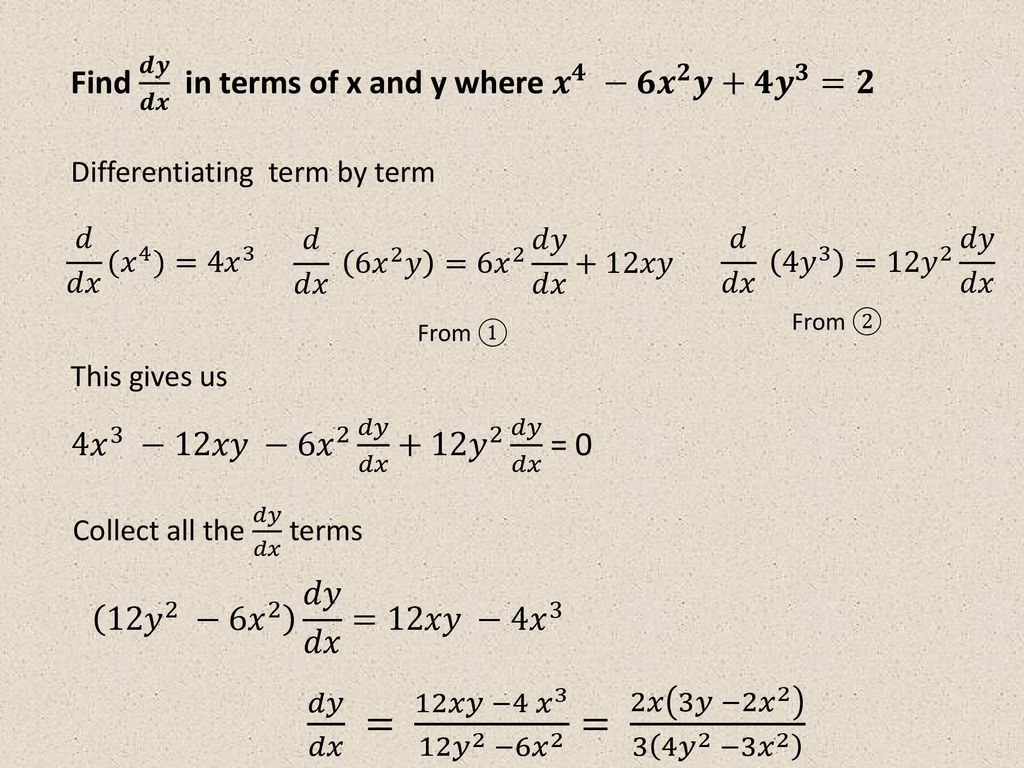



Differentiation Ppt Download



Find Dy Dx Xy Y 2 Tan X Y Sarthaks Econnect Largest Online Education Community




Find Dy Dx By Implicit Differentiation Xey X Y Blog Lif Co Id
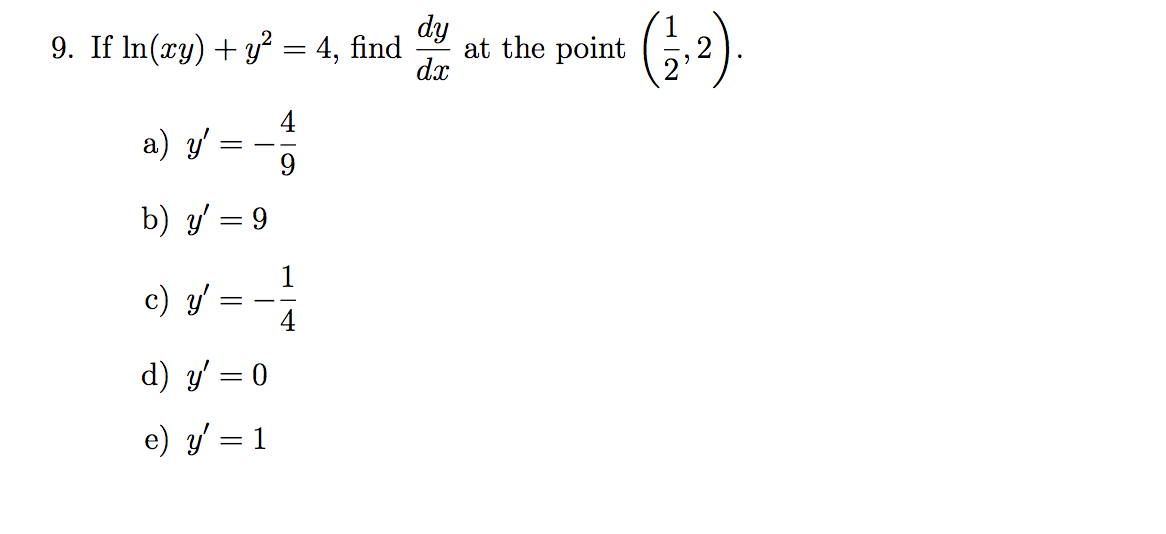



If Ln Xy Y 2 4 Find Dy Dx At The Point 1 2 Chegg Com




Example 37 Find Dy Dx If X2 3 Y2 3 3 Ncert Examples
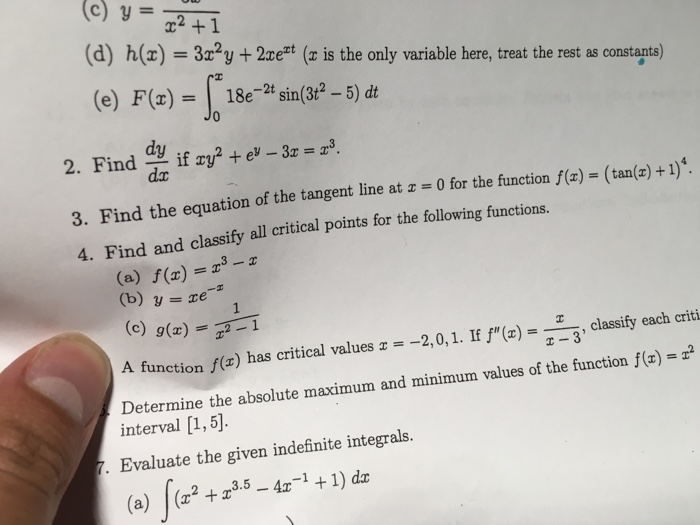



Find Dy Dx If Xy 2 Xy 2 E Y 3x X 3 Find The Chegg Com
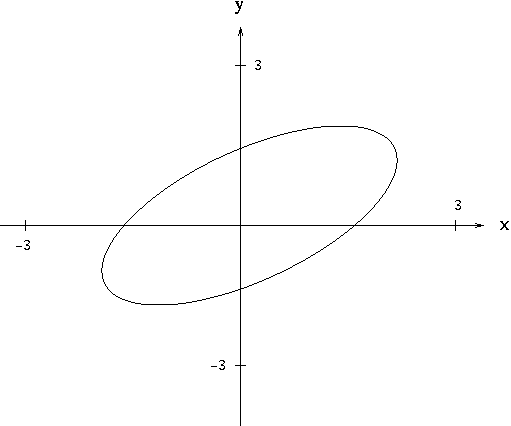



Implicit Differentiation



Madasmaths Com Archive Maths Booklets Standard Topics Various Differentiation Ii Exam Questions Pdf



Secure Media Collegeboard Org Digitalservices Pdf Ap Ap16 Calculus Q4 Pdf
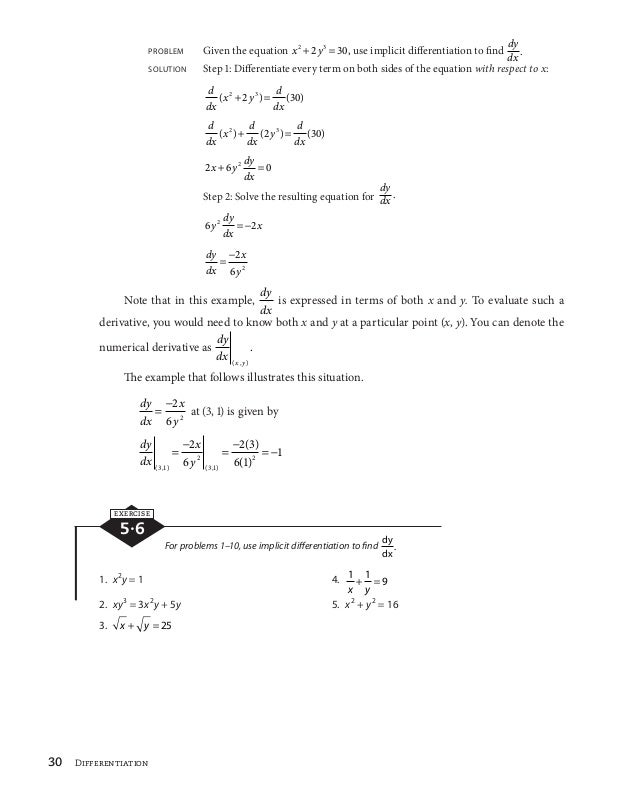



Difrentiation Phpapp01




Find Derivative Dy Dx Of X 2y Xy 2 6 Implicit Differentiation Youtube




Q2 If X 2 Y 2 4 Find Dy Dx Implicit Function Differentiation If X2 Y2 4 Find Dy Dx Youtube




Ex 5 6 4 Find Dy Dx X 4t Y 4 T Chapter 5 Class 12



If X 2 Y 2 2 Xy Find Dy Dx Sarthaks Econnect Largest Online Education Community
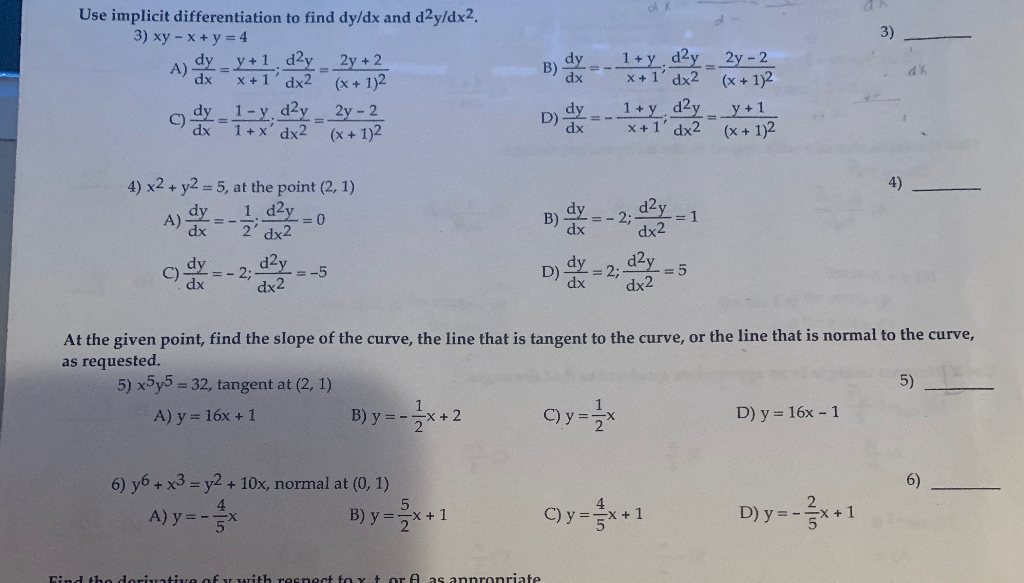



Use Implicit Differentiation To Find Dy Dx And Chegg Com
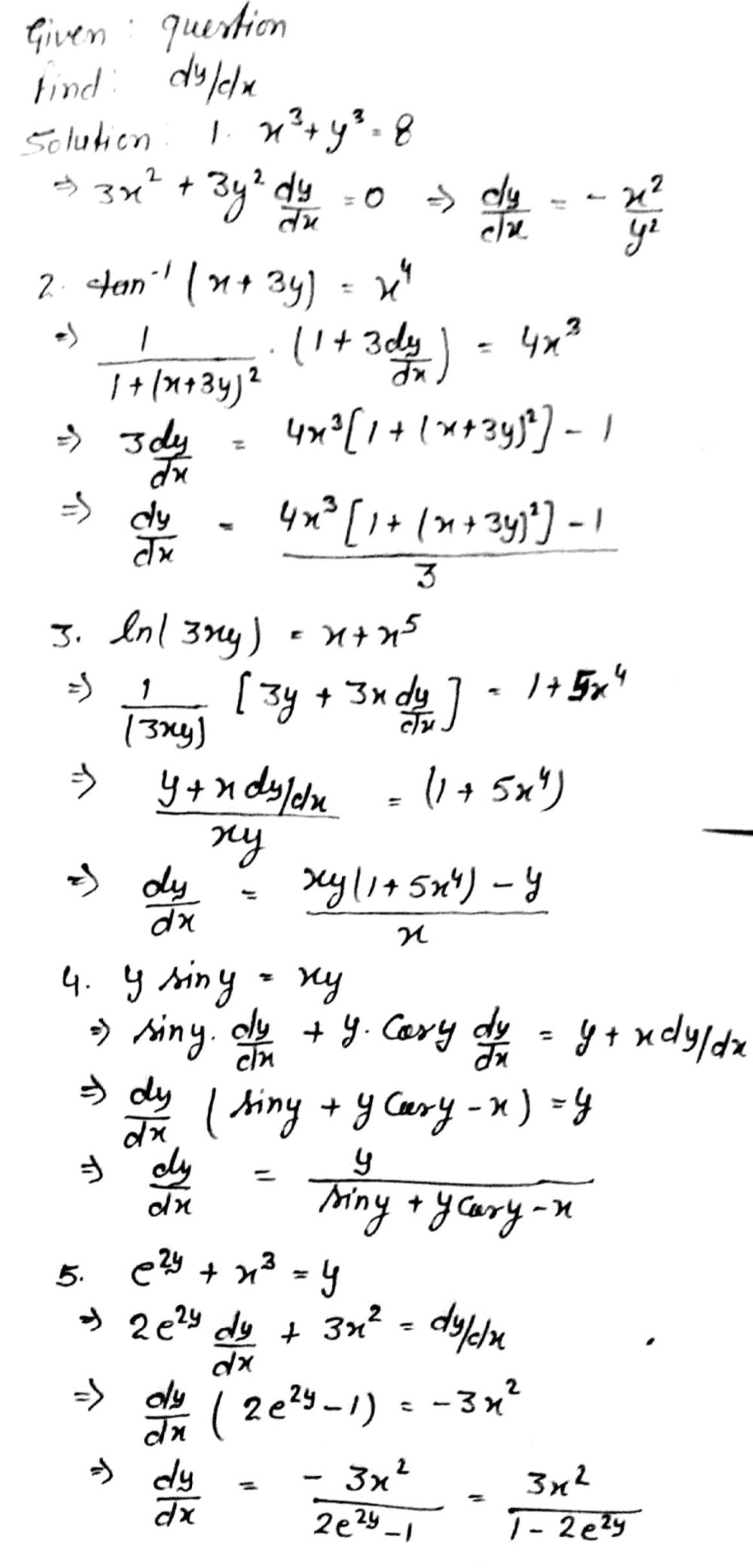



L Find Dy Dx Of The Followin 1 X3 Y3 8 2 Tan Gauthmath
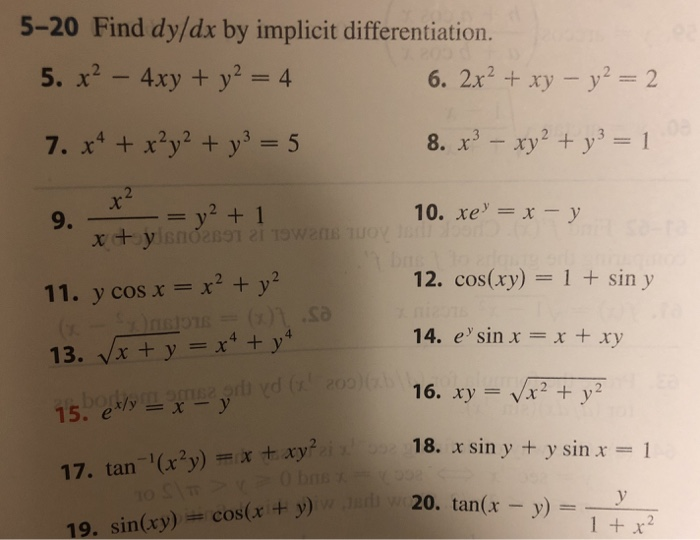



5 Find Dy Dx By Implicit Differentiation 6 2x2 Chegg Com
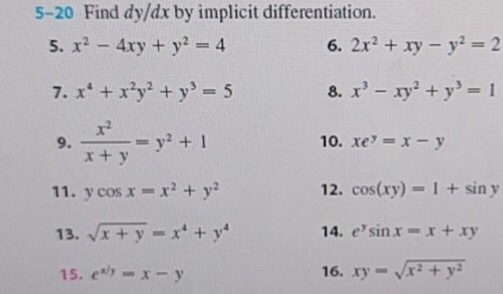



Find Dy Dx By Implicit Differentiation X 2 4xy Chegg Com




Implicit Differentiation Implicit Differentiation Is Used To Differentiate




Find Dy Dx In The Following A X 3 X 2y X Y 2 Y 3 81 B Xy Y 2 Tan X Y C X 2 Xy Y 2 100
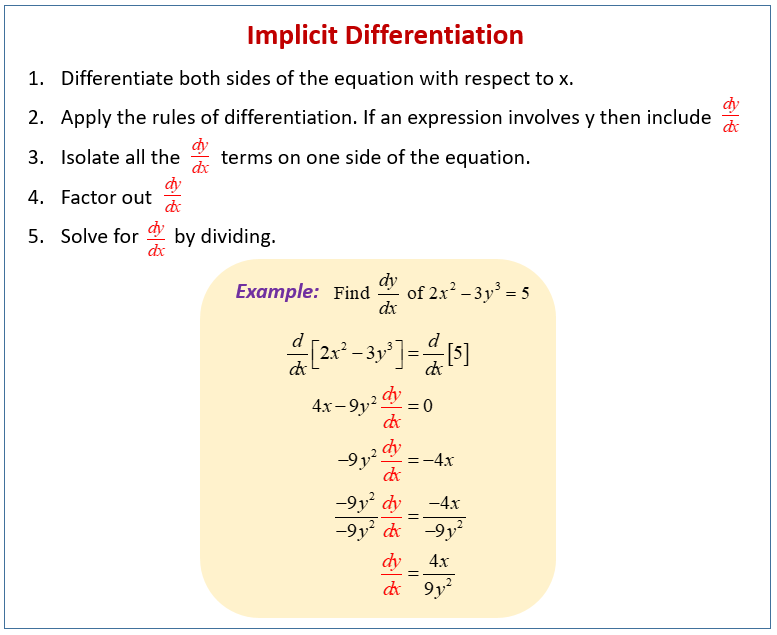



Examples Using Implicit Differentiation Solutions Formulas Videos



Www Lcps Org Cms Lib Va Centricity Domain 2 5 notes filled out Pdf




Find Dy Dx If X 5 Xy 3 X 2y Y 4 4 Brainly In



1




X 2 Y 2 1 Find Dy Dx By Implicit Differentiation Youtube



Q Tbn And9gcq69xqaiwgxy95 44f5sqsm2pnlgxvor Roue6xadfczqpkv4qx Usqp Cau



Q Tbn And9gcq9arl5ab K Kkztqdma6czzlslnfprp6ljv7o6a18 5qqda4yy Usqp Cau




Find Dydx If X 2 Xy Y 2 100



Part A X 2 4 Y 2 7




Ex 5 3 5 Find Dy Dx In X2 Xy Y2 100 Class 12
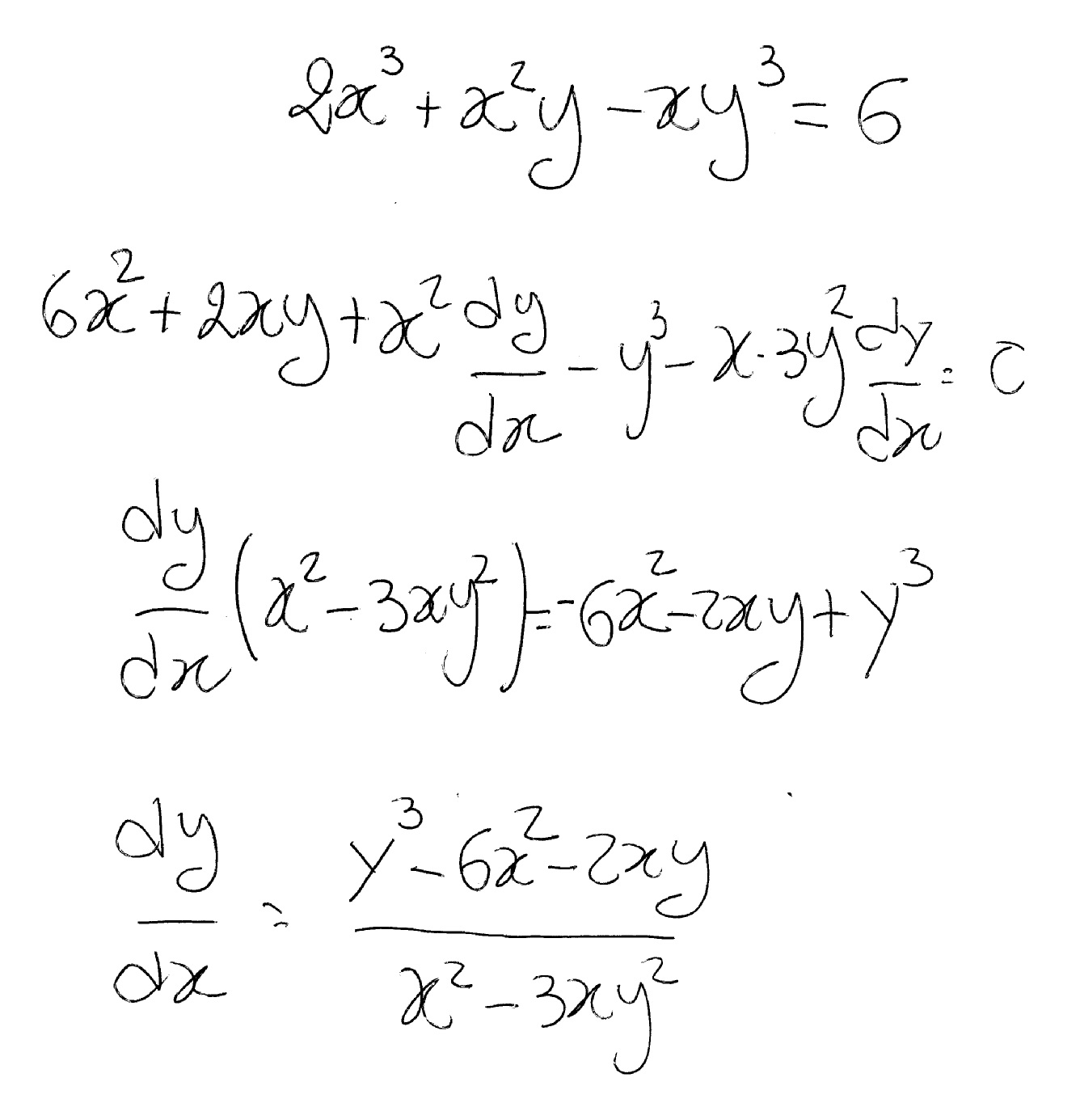



How Do You Find Dy Dx By Implicit Differentiation For 2x 3 X 2 Y Xy 3 6 Socratic




Find Dy Dx For E Xy 2y Study Com




Find Dy Dx When E Xy 4xy 4



4 2 Implicit Differentiation



0 件のコメント:
コメントを投稿